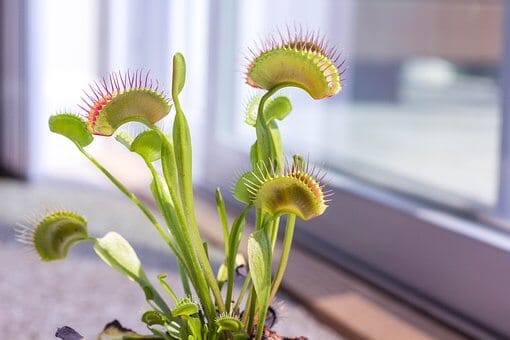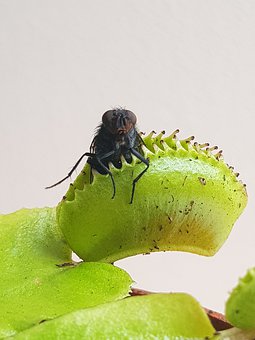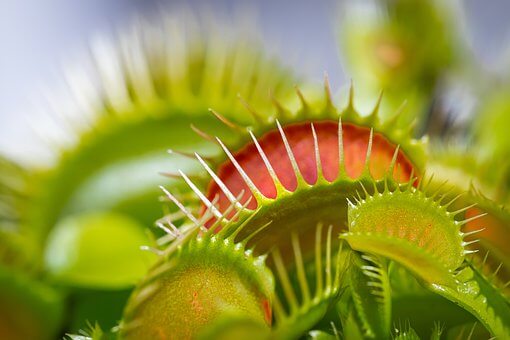Last Updated on March 6, 2023 by a Friendly Gardener
The Venus Fly Trap, an illustrious member of the Droseraceae family, is botanically named the Dionaea muscipula. This is a unique representative of the plant world. The plant’s feeding habits are carnivorous, and it boasts a very original appearance. This plant eats insects and may end up being the center of discussion, especially if engaged in dining.
The genus Dionaeasignifies “daughter of Dione”. It refers specifically to the Greek goddess Aphrodite. Venus, instead, alludes to the Roman goddess of love. These goddesses were associated with food-producing fields, love, beauty, prosperity, desire, fertility, and sex. That’s a lot of responsibility for a goddess. The species name “muscipula” translates to mousetrap from Latin.
The Venus Fly Trap is not a difficult plant to cultivate, although it requires conditions that are somewhat different than other popular houseplants.
This plant is famous for its “fly trap” which is unique plant foliage. Each plant can produce up to eight traps. Most cultivars will grow an inch or two in height and width.

Famous for its carnivorous nature, foliage features two lobes that appear like a pair of lips held together with a natural “hinge”. Sweet sticky nectar is produced inside the two lobes as bait to attract bugs. Once an insect enters, it triggers hairs embedded in the lobes and they spring shut.
The insect remains trapped in a type of cage formed by the lobes with interlocking teeth. As the bug fights to free itself, the trap seals shut. Digestive enzymes are released that dissolve the bug’s soft tissue. Depending on the type and size of the bug, the plant will digest it in four to ten days.
The flytrap absorbs the liquid nutrition leaving the bug’s carcass as bait for other insects once jaws reopen.
The Venus flytrap is native to North and South Carolina coastal bogs. Destruction of its natural habitat has placed the plant’s survival at risk. It is considered extinct in a number of its native counties. Horticultural scientists have tried cultivation in new locations, however, this presents problems as it can interfere with established ecological bio-systems in the new zones.
While significantly easier to grow outdoors, with proper care, it can be cultivated successfully.
Venus Fly Trap Care

Most Venus flytraps are cultivated in indoor containers. Our Venus has specific requirements, and the cultivation environment should replicate the plant’s natural habitat.
The Venus Fly Trap grows spontaneously in “bogs”. Bogs are sunny with poor soil with little nutrients to offer but are naturally acidic and wet. The Flytrap plant takes its nutrients from bugs because environmental soil does not contain them.
Soil
Venus wants acidic soil. Mix peat moss with horticultural sand in equal measure for an adequately acidic soil bed. Flytraps are not to be cultivated in potting soil or garden soil.
Other alternatives include:
- one part of perlite mixed with two parts of peat moss
- equal amounts of perlite and peat moss
- high-quality long-fiber sphagnum
Light
Your Venus should have access to approximately twelve hours of sunlight daily. The Fly Trap enters dormancy in the fall when the sunlight decreases naturally due to shorter day lengths. It will appear as if dying, losing its famous foliage. Its rhizomes continue to live underneath the soil surface. The plant’s normal habitat featuring reduced sunlight should be continued. Do not supplement with artificial light.
Outdoor Flytrap cultivation requires four or more hours of direct sunlight together with two to four hours of sunlight that is indirect.
Water
The Venus Flytrap needs more water than other houseplants. Provide rainwater and avoid municipal tap water. Leave a container outdoors to collect rainwater for this plant. If not possible, use distilled water for moisture needs. The Venus is sensitive to water with chlorine, salts, and minerals.
Soil should be kept medium moist to wet always as this is a bog creature. The soil must not dry out ever. You can place the plant in a saucer of water for several hours every several days for convenience. During dormancy in the fall, reduce watering.
Humidity
Humidity does not need to be high and just a bit over 50% is ideal. These plants can be cultivated indoors in an open terrarium that will aid humidity requirements. Do not cultivate them in closed terrariums. Rot can develop in closed terrariums. Outdoors, terrarium cultivation becomes dangerous as glass will increase the sun’s strength and possibly burn or scorch leaves.
Temperature
The Venus flytrap loves temperatures measuring between 70° and 95° F. During dormancy temperatures should measure from 35° to 50° Fahrenheit. Venus can tolerate temperatures as low as 20° F. during dormancy.
Feeding Your Venus Flytrap

Do not give fertilizer to your Venus flytrap plant. It can be lethal and kill the plant. You do need to feed your plant, nonetheless. Your plant will trap some bugs by itself. Still, it’s recommended that you feed it live gnats, flies, or mosquitoes. Once you catch a bug, transfer it to the plant using terrarium tweezers. Insert the bug into the plant’s trap. With insertion, the insect should trigger the foliage hairs inside and the jaws should snap shut.
Keep an updated diary of when you feed the plant’s traps. Individual traps have a specific limited number of how many times they can open and close during the trap’s lifespan. Never feed the plant during its dormant period. Do not feed your Venus flytrap meat or other types of human food, as it is only able to digest bugs. One or two bugs per month tops will satisfy your Venus Flytrap plant’s dietary needs.
Pruning
Unless you intend to gather seeds for propagation, remove the plant’s flower upon blooming. Flowering produces seeds but also diverts needed energy from the plant.
Pests, Diseases, and Problems
Clearly, the plant is more of a threat to bugs than bugs are to this plant. It can however be bothered by aphids as well as fungus gnats. They are too small to be successfully eaten by the plant.
In autumn, the Venus Fly Trap enters its traditional dormant period. Leaves become blackened and die back. If traps stay open and do not close, this is a sign that your plant is going to sleep for the winter. Your plant will usually sleep for three to four months.
The Venus Fly Trap is not dead. Lower temperatures and short winter days trigger dormancy. Place your Fly trap in a cool, unheated basement, garage, or similar. It does not require particular light but can rest in the vicinity of a window.
When spring temperatures rise into the 50s Fahrenheit, remove dead foliage and place it in a sunny spot for regeneration.
Venus Fly Trap Toxicity
The Venus Fly Trap is considered non-toxic to pets, and humans. The plant’s jaws are not sufficiently strong to harm humans or pets. Avoid putting your finger in the trap. It will not harm you but will deplete your Fly trap’s energy which is needed for trapping insects.
Venus Fly Trap Propagation

The Venus Fly Trap can be propagated with seeds although, more often than not, unsuccessfully. The division of your plant in the springtime has a better probability of success.
A Single Species for Many Cultivars

The plant has only a single species, enthusiasts have developed however numerous cultivars. Many of these distinguish themselves according to color. Some are entirely green, others feature some green, while others may boast yellow, red, or even purple.
- Dionaea “Purple Haze” offers deep purple-hued traps.
- Dionaea “Flaming Lips” features brilliant orange traps.
- Dionaea “Petite Dragon” is a tiny Venus Fly Trap with a one-half-inch trap at its largest.
- Dionaea “Justina Davis” is totally green in color.
- Dionaea “Ginormous” is the largest of Venus Fly Trap 2.25-inch traps.
A Final Thought
Venus Fly Trap plants can live to be quite old in their natural habitats. When cultivated, they tend to be short-lived most often due to a lack of proper care. Be careful not to trigger traps unless feeding one. As each individual trap has a limited number of openings and closings during its life, do not waste the plant’s energy on triggering a trap for any reason other than feeding as it will hasten its death. These plants make exciting additions to home gardens with attention to their needs.

